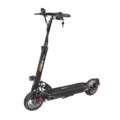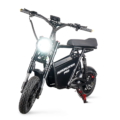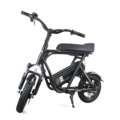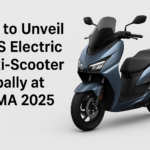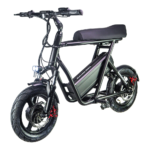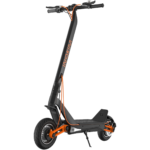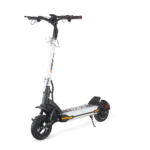- Home
- Scooters
- Electric Scooters
- EMOVE RoadRunner Tronic
EMOVE RoadRunner Tronic
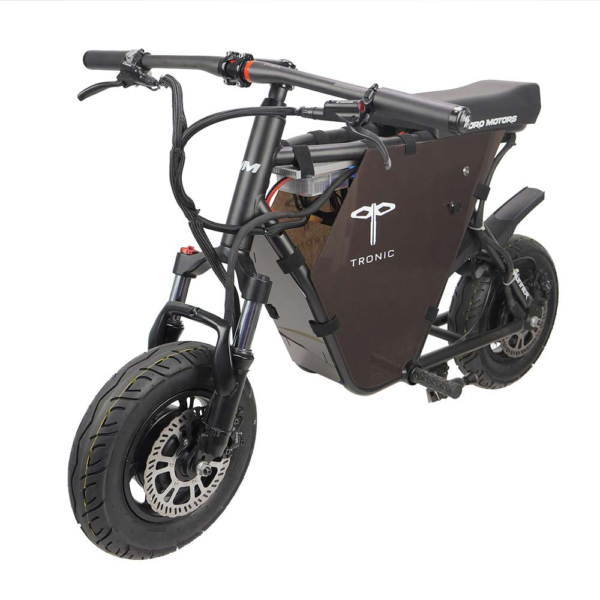

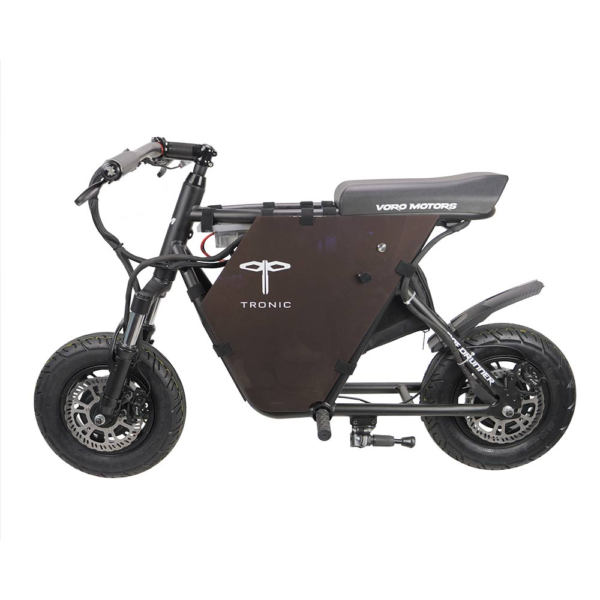
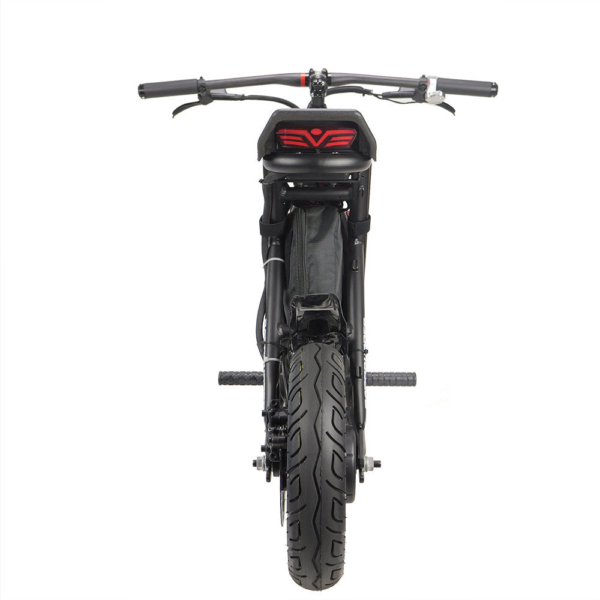
- Battery Range: 65 miles (105 km)
- Top Speed: 60 mph (97 km/h)
- Motor Power: Dual 5000W
- Weight Capacity: 280 lb (127.0 kg)
- Charging Time: Not specified
- Scooter Weight: Not specified
PROS
- Dual 5000W motors (10 kW total)
- 72V 28Ah battery (~2.0 kWh)
- 4-piston hydraulic brakes
- Front adjustable damping (ABS+)
- VESC control with Rion Curve throttle
CONS
- No headlight or display stock
- No official IP rating
- Premium price; niche use
Key Takeaways
- The EMOVE RoadRunner Tronic is a high-speed seated scooter with dual high-output hub motors and a powerful 72 V battery.
- It features advanced VESC controllers for precise control and a Rion Curve thumbwheel for smooth throttle input.
- The scooter offers a top speed of 60 mph (97 km/h) and a range of approximately 65 miles (105 km).
- Design-wise, it includes a compact frame with large pneumatic tires for comfort and stability but lacks a built-in display or headlight.
- Ideal for speed enthusiasts and tinkerers, it’s less suited for first-time riders or those needing a foldable design.
Table of contents
- What Is the EMOVE RoadRunner Tronic?
- How the EMOVE RoadRunner Tronic Works
- Key Specifications
- Design & Build Quality
- Performance Fundamentals
- Battery, Range & Efficiency
- Ride Quality & Comfort
- Braking & Safety Features
- Portability & Daily Usability
- Maintenance & Care
- Weather & Seasonal Considerations
- EMOVE RoadRunner Tronic vs Alternatives
- Who the EMOVE RoadRunner Tronic Is (and Isn’t) For
- FAQs
- Glossary
- Final Notes on fit and setup
The EMOVE RoadRunner Tronic is a seated “hyper” scooter built for speed and sharp control. It pairs dual high-output hub motors with a 72 V battery and VESC controllers, so it hits hard off the line and stays smooth. If you want motorcycle-like punch in a compact frame, this fits. And if you already like the RoadRunner idea but want the wild one, this is it. For a calmer sibling, see the EMOVE RoadRunner SE. The official specifications call out up to 60 mph (97 km/h) and roughly 65 miles (105 km) of range, so expectations start high.
What Is the EMOVE RoadRunner Tronic?
The EMOVE RoadRunner Tronic is a special RoadRunner built with Tronic Systems. It keeps the small, rigid frame and big wheels, then swaps in premium electronics and controls. You get dual VM 5000 W hub motors, dual Tronic 250 VESC controllers, and a Rion Curve thumbwheel throttle for extra-fine input. There’s no built-in headlight or display here. So you check stats and tune settings with a VESC-compatible phone app. And you still sit on a compact saddle with foot pegs and a BMX-style bar, which feels planted and calm at speed.
How the EMOVE RoadRunner Tronic Works
Motor system. Two powerful hub motors sit in the wheels. They spin up with little lag and keep pulling as speed builds. So launches feel strong, and quick passes feel easy.
Controller logic. The Tronic 250 VESC units sample the thumbwheel fast. Then they shape phase current to match your input. The response feels precise, and traction is easy to meter on loose patches. Since it’s VESC, you can edit current limits, throttle curves, and electronic braking inside the app.
Battery pack. A 72 V 28 Ah LG pack feeds the system. That’s about 2,016 Wh of energy (72 V × 28 Ah). So you cruise longer at pace and still have headroom for hills and repeated pulls.
Throttle. The Rion Curve thumbwheel runs smooth and short-throw. Your hand stays relaxed on longer rides.
Brakes. Four-piston Zoom hydraulic calipers clamp front and rear. Lever feel is firm after the first bit of travel, and fade resistance is solid on repeated stops.
Suspension and wheels. An adjustable-damping front fork knocks down sharp hits. Plus, big pneumatic tires add grip and a soft layer of comfort. So the scooter tracks straight, holds a line, and resists headshake at speed.
Key Specifications
The figures below reflect the official listing for the EMOVE RoadRunner Tronic. When something isn’t published, we note “Not stated.” Use this table as a quick specifications reference.
General
| Item | Value |
|---|---|
| Model | EMOVE RoadRunner Tronic |
| Configuration | Seated, dual-motor |
| Frame | Alloy frame with carbon-fiber cockpit panel |
| Wheel type | Large pneumatic tires with inner tubes |
| Included display | None (VESC app for stats) |
Performance & Power
| Item | Value |
|---|---|
| Top speed | Up to 60 mph (97 km/h) |
| Motors | Dual VM 5000 W hub motors |
| Controllers | Dual Tronic 250 VESC |
| Drive | Dual wheel, hub-drive |
Battery, Charging & Electrical
| Item | Value |
|---|---|
| Battery | 72 V 28 Ah LG cells |
| Energy | ~2,016 Wh (computed) |
| Claimed range | ~65 mi (105 km) |
| Charger | Not stated |
| App | VESC mobile apps (iOS and Android) |
Build & Dimensions
| Item | Value |
|---|---|
| Unfolded dimensions | Not stated |
| Folded dimensions | Non-folding main frame; handlebar space for add-ons |
| Seat | Compact padded saddle |
| Tires | Pneumatic, inner tube |
| Suspension | Front adjustable damping; no rear suspension listed |
Safety & Control
| Item | Value |
|---|---|
| Brakes | Zoom 4-piston hydraulic |
| Lights | No built-in headlight or display (mount points available) |
| IP rating | Not stated |
Features & Extras
| Item | Value |
|---|---|
| Throttle | Rion Curve thumbwheel |
| Cruise Control | Not stated |
| Connectivity | VESC app for tuning and telemetry |
| Accessories | Room on the bars for add-ons |
Warranty & Compliance
| Item | Value |
|---|---|
| Warranty | One-year limited warranty on new scooters |
| Max rider load | 280 lb (127 kg) |
| Notes | Water damage is commonly excluded; ride dry when possible |
Design & Build Quality
The Tronic keeps the compact RoadRunner chassis and adds a carbon-fiber cockpit panel, so the layout looks clean and focused. Welds feel stout, and fasteners sit flush. The cockpit stays simple since the phone app replaces a dash. You get a short stem with BMX-style bars, a right-hand thumbwheel, and space for a light, a mount, or a phone holder.
The seat is narrow enough to grip with your legs and long enough to shift fore and aft. So you can slide forward for launches and scoot back for braking. Foot pegs sit at a neutral height, and the mid-section gives your heels room. The low frame helps stability, and the wheelbase keeps the bike settled when the pace climbs.
Up front, the fork uses adjustable damping. So you can add rebound to calm the front after bumps. Then you can add compression for square-edge hits. The big pneumatic tires soften chatter and boost grip on rough city pavement.
There’s no built-in headlight or display. Even so, the bare cockpit reduces clutter and gives you freedom to add the parts you like. The VESC app shows speed, voltage, current, and logs when you need a quick check.
Performance Fundamentals
Launch and mid-range. Crack the thumbwheel and torque arrives cleanly. So standing starts feel brisk. Mid-range pull gives you easy passes. Then the top end builds in a steady way that feels composed, not twitchy.
Stability. The geometry favors straight-line stability. Big wheels track across seams and joints without drama. And the short cockpit keeps weight low, so lane changes feel calm.
Hills. On 7–10% grades, the Tronic holds speed with little fuss. You can sit and let the motors work. A small lean forward keeps the front planted, and the precise throttle helps you keep traction.
Heat. Long climbs and repeated sprints build heat in any setup. Even so, the hardware runs well when current limits are set with some margin. So pick sane settings in the app, and prefer smooth inputs over spikes.
Battery, Range & Efficiency
The 72 V 28 Ah pack holds about 2,016 Wh. On paper, that supports ~65 mi (105 km) at a steady, modest pace on flat ground in mild weather. In the real world, range moves around. And rider weight, average speed, and temperature swing results the most.
At 190–220 lb (86–100 kg) with mixed city riding, many riders see mid-to-upper-30s in miles on one charge when cruising fast and braking hard. Ease off a bit, and the numbers climb. Keep tires at proper pressure, avoid soft sand and strong headwinds, and you stretch your ride further.
So charge with care. Stop short of full for daily trips. Then charge to 100% before longer rides. Let the pack cool before charging after hard sessions. And store it near the middle if it will sit for a while. Small habits like these help the pack hold capacity.
Ride Quality & Comfort
The front fork sets the tone. Turn the dials a few clicks at a time, then ride the same block and feel the change. A touch more rebound reduces front bob when you release the brake. A bit more compression helps on sharp square-edge bumps.
Big pneumatic tires add a second layer of comfort. They chew up small chatter that would rattle smaller wheels. The seat is firm enough for control and soft enough for an hour or so. If you want plush, add a thin air cushion and keep the seat low to manage reach.
Stem flex stays low thanks to stout parts and a short stack. The cockpit stays quiet at speed. For extra leverage, add bar ends if you have larger hands. Then keep your eyes up and your shoulders loose over plates and joints.
Braking & Safety Features
Zoom four-piston hydraulics bite with confidence. Lever throw is short, and bite ramps up after about half a pull. So trail braking feels easy, and you can still add pressure if traffic shifts.
Use two fingers, so your thumb can rest on the throttle for balance at walking speed. Check rotor alignment after your first week. Fresh pads can bed in slightly off center, and a tiny adjustment stops light rubbing.
Lights are add-on only here. So mount a bright headlight, a strong tail light, and reflective gear. Then aim lights low enough to avoid glare for oncoming riders and drivers. There’s no listed IP rating, so plan rides with that in mind and stick to dry days when you can.
Portability & Daily Usability
This is a compact seated machine, but it isn’t a featherweight toy. The frame does not fold. Even so, the footprint is short and narrow, so storage in a hallway or garage is simple. The bar area has room for a lock mount and a light.
For transport, a hitch rack rated for small motorcycles makes life easier. So strap the frame at two points and the front wheel at one. Then check straps after ten minutes of driving and again at stops.
For daily use, add a clear bell, a mirror, and a kickstand puck for soft ground. Keep a small pump and a plug kit in a saddle bag. With that kit, flats and quick stops feel less stressful.
Maintenance & Care
Before each ride. Check tire pressure. Spin wheels to catch rub. Squeeze each lever to confirm firm bite. Then pick a mellow throttle map if you’ll ride through crowds.
Weekly. Inspect rotor bolts and axle nuts. Wipe fork stanchions and clean the sliders. Add a drop of blue threadlocker to any bolt that backed out. Check the headset by holding the front brake and rocking the bars.
Monthly. Bleed brakes if the lever feels spongy. Inspect pads and replace when the compound thins out. Then review VESC logs for heat spikes or current peaks you can smooth with gentler throttle curves.
Battery care. Keep the pack between about 20% and 85% for daily use. Top off to full only before longer rides. Store the scooter cool and dry. Water damage usually isn’t covered, so keep things dry and wipe moisture off after use.
Weather & Seasonal Considerations
Rain cuts traction and can harm unsealed parts. The Tronic has no stated IP rating, so dry days are best. If you hit wet patches, slow down, stay upright, and skip paint, plates, and leaves. Cold weather trims range, and hot sun raises pack temps. So watch voltage in the app and let the pack cool before charging.
Wind matters too. A steady headwind near 15 mph (24 km/h) can knock range at higher speeds. So lower your torso and ease the throttle a bit. Keep your upper body loose when gusts hit, and let the bike self-correct.
EMOVE RoadRunner Tronic vs Alternatives
Against commuter scooters. The Tronic makes most commuter models feel soft. It accelerates harder, climbs steeper hills, and holds higher speeds with ease. But it lacks built-in lights and a display, and it isn’t a last-mile foldable.
Against performance stand-ups. Many stand-ups match the top end on paper. Even then, the seated stance changes the feel. You sit lower, so the bike stays calmer over rough patches. And the thumbwheel gives fine control for tiny inputs.
Against the RoadRunner Pro. The Pro brings lights, a display, and full suspension. The Tronic brings VESC tuning and a sharper, more direct feel. So choose the Pro for comfort and completeness. Choose the Tronic for raw control and top-end thrills. On paper, the specifications point each model at a different rider.
If long range and a stand-up deck sound better for daily rides, the EMOVE Cruiser V2 makes a strong case.
Who the EMOVE RoadRunner Tronic Is (and Isn’t) For
Great for:
- Riders who want seated speed in a compact format.
- Tinkerers who like shaping power and braking in software.
- Short to mid-length commutes with hills and quick passes.
- Weekend sprints on open roads or quiet industrial parks.
Not ideal for:
- Riders who need a foldable, train-friendly machine.
- Very wet regions, since there’s no listed IP rating.
- First-time riders who want a gentle starter.
If you know the RoadRunner line and want the spicy one, the EMOVE RoadRunner Tronic is it. And if you prefer a turn-key setup with lights and a dash, the Pro fits better.
FAQs
1) How fast is the EMOVE RoadRunner Tronic?
The official top speed is about 60 mph (97 km/h) in ideal conditions. Real-world numbers shift with rider weight, grade, and tune. Try settings in a safe lot first.
2) What battery does it use?
A 72 V 28 Ah LG pack with about 2,016 Wh of energy. That supports strong bursts, steady cruising, and plenty of hill work.
3) Does it have a headlight or a display?
No. The Tronic ships without a headlight or a dash. So you use a VESC phone app for stats and tuning, then add your own lights.
4) What is the max rider weight?
The listed maximum load is 280 lb (127 kg). Count your cargo and add-ons when you plan setup, and check hardware tightness weekly.
5) Can I use cruise control?
Cruise control isn’t listed. Even so, you can shape throttle curves in the app to keep a steady hand with less effort.
6) Is it safe to ride in the rain?
There’s no published IP rating. So skip heavy rain and avoid direct spraying when cleaning. Add bright lights and reflectors if you must ride at dusk.
7) Where can I find an “EMOVE RoadRunner Tronic overview” in short form?
Jump to the Key Specifications table. It covers power, battery, brakes, and core features in one place.
Glossary
Ah (amp-hours). Battery capacity. Higher Ah means a larger “gas tank.”
Wh (watt-hours). Battery energy. Volts × amp-hours. Quick guide to range.
VESC. Open motor controller platform for fine-tuning power and braking.
Controller. The unit that regulates current to the motors.
Phase current. Current in the motor windings. It sets low-speed torque feel.
Throttle curve. A map that converts thumbwheel position into motor output.
Regen braking. Motor-based braking that feeds energy back into the battery.
ABS+ damper. An adjustable damping cartridge used in some forks.
Stem flex. The small bend you feel in the bar stem under load.
IP rating. Two-digit code for dust and water resistance.
Peak power. Short-term maximum output for bursts.
Sine wave controller. A controller style that runs motors smoothly at low speed.
Pneumatic tire. Air-filled tire that cushions impacts and boosts grip.
Four-piston caliper. Brake caliper with two pistons per side for higher clamp force.
Thumbwheel throttle. A small rotary lever for precise right-hand input.
Final Notes on fit and setup
Start with a mellow throttle map, then step up. Next, tune the fork with a few passes on the same block. Keep tire pressures even front to rear, and check them weekly. Then log rides in the app for a month, so you can see how small tweaks change heat and efficiency.
Specifications
General
| Model The Model specifies the exact version or name of the scooter. It helps identify its unique design, features, and specifications within the manufacturer’s product line. Knowing the model makes it easier to compare options, find compatible accessories, or look up support information. | RoadRunner Tronic |
| Brand The Brand identifies the manufacturer or company that designs and produces the scooter. A trusted brand is a sign of quality, reliability, and good customer support. Well-known brands often have higher standards for safety, performance, and after-sales service, giving you more confidence in your purchase. | EMOVE |
| Release Date The Release Date indicates when the scooter model was officially launched on the market. This helps you know how current the design, technology, and features are. A newer release date often means updated components, improved performance, and the latest safety or smart features. | 18 November 2025 |
| Recommended Age Recommended Age indicates the minimum age range that the scooter is designed for, based on safety, size, and ease of use. Following the recommended age helps ensure that riders can handle the scooter’s speed, weight, and controls comfortably and safely. Always check local laws and use protective gear, especially for younger riders. | +16 |
Performance & Power
| Motor Power (Wattage) What it means: The motor power, measured in watts (W), shows how strong the scooter’s electric motor is. Why it matters: Higher wattage usually means better acceleration, more torque, and improved performance on hills or rough terrain. For example, a 250W motor is good for flat city roads and light riders, while a 500W or 1000W motor provides more power for faster speeds or climbing steep inclines. | Dual 5000W hub motors (10,000W total) |
| Top Speed The Top Speed indicates the maximum speed that the scooter can reach under optimal conditions. It’s usually measured on level ground with a fully charged battery and an average rider weight. A higher top speed allows you to travel longer distances faster, but always ensure you ride within legal speed limits and your personal comfort zone for safety. | 60 mph (97 km/h) |
| Battery Capacity Battery Capacity refers to the total amount of energy the scooter’s battery can store, usually measured in ampere-hours (Ah) or watt-hours (Wh). A higher battery capacity means you can ride longer distances on a single charge, reducing the need for frequent recharging. Keep in mind that actual range can vary depending on rider weight, terrain, speed, and weather conditions. | 72 V 28 Ah (≈2,016 Wh) |
| Estimated Range per Charge The Estimated Range per Charge indicates the average distance the scooter can travel on a single full battery charge. This range is calculated under optimal conditions, such as flat terrain, moderate speed, and average rider weight. Real-world range may vary depending on riding style, terrain, weather, and load. A longer range means fewer recharges and greater freedom for longer trips. | 65 miles (105 km) |
| Hill Climb Ability Hill Climb Ability describes the maximum incline or slope that the scooter can handle while maintaining stable performance. It’s typically expressed as a percentage or in degrees. A higher hill climb rating means the scooter can tackle steeper hills without losing too much speed or power. Actual climbing performance may vary based on rider weight, battery charge, and terrain conditions. | Not specified |
| Drive System The Drive System refers to how power from the motor is delivered to the wheels. Electric scooters typically use either a hub motor (directly integrated into the wheel) or a chain/belt drive system. A high-quality drive system ensures smooth acceleration, efficient power transfer, and low maintenance. The choice of drive system affects performance, noise level, and overall ride experience. | 2WD (front+rear hub) |
Charging & Electrical
| Charging Time Charging Time indicates how long it takes to fully recharge the scooter’s battery from empty to 100% using the standard charger provided. Faster charging means less downtime and more time on the road. Actual charging time may vary slightly depending on battery capacity, charger output, and environmental conditions. | Not specified |
| Battery Type Battery Type refers to the specific technology used in the scooter’s battery, which affects performance, lifespan, weight, and charging time. Most modern electric scooters use high-quality lithium-ion (Li-ion) batteries because they offer a good balance of energy density, durability, and low maintenance. A reliable battery type ensures consistent power delivery and longer riding ranges. | Lithium-ion (LG) with BMS |
| Removable Battery A Removable Battery means the battery pack can be easily detached from the scooter for convenient charging and replacement. This feature allows you to charge the battery separately, swap it with a spare for extended range, or securely store it indoors in extreme weather. Removable batteries add flexibility and make it easier to keep your scooter powered up wherever you are. | Not specified |
| Regenerative Braking Regenerative Braking is an energy-saving feature that converts some of the energy normally lost during braking back into battery power. When you slow down or brake, the motor works in reverse to generate electricity, which helps extend the scooter’s range and improves overall efficiency. This system also reduces wear on traditional brake components, leading to lower maintenance over time. | Not specified |
| Lighting Lighting refers to the built-in front and rear lights that enhance visibility and safety when riding in low-light conditions or at night. Good lighting helps you see the road ahead and ensures that other road users can see you. Many scooters include LED headlights, taillights, and sometimes brake lights or side reflectors for added safety and compliance with local traffic regulations. | No headlight or display (aftermarket recommended) |
Build & Dimensions
| Scooter Weight Scooter Weight refers to the total weight of the scooter when fully assembled, including the battery. This affects how easy it is to carry, lift, and store the scooter when not in use. A lighter scooter is more portable and convenient for commuting, especially if you need to carry it upstairs or onto public transport. Keep in mind that a sturdy frame and quality components may add to the weight but also contribute to better durability and ride stability. | Not specified |
| Maximum Rider Weight Maximum Rider Weight indicates the highest rider weight that the scooter is designed to safely support while maintaining optimal performance and stability. Staying within this limit helps ensure reliable acceleration, braking, and climbing ability, and it protects the frame, suspension, and motor from excessive strain. Exceeding the recommended limit may reduce performance and increase wear on components. | 280 lb (127.0 kg) |
| Deck Size Deck Size refers to the dimensions of the scooter’s standing platform. A wider and longer deck provides more foot space, allowing you to stand comfortably and adjust your stance while riding. A well-sized deck improves balance and stability, especially on longer rides or at higher speeds. Compact decks, on the other hand, help keep the scooter lightweight and portable. | Seated hyperscooter; reinforced frame; carbon cockpit |
| Handlebar Height Handlebar Height refers to the distance from the deck to the handlebars, which affects your riding posture and comfort. An appropriate handlebar height helps you maintain good balance, reduces strain on your back and arms, and makes steering more comfortable. Some scooters have adjustable handlebars to fit riders of different heights, while others have a fixed height for a streamlined design. | Fixed (carbon cockpit) |
| Folding Mechanism The Folding Mechanism describes how easily and securely the scooter can be folded for carrying and storage. A well-designed folding system lets you quickly collapse the scooter into a compact size, making it convenient to transport on public transit, store under a desk, or fit into a car trunk. Look for sturdy latches and safety locks to ensure the scooter stays firmly in place when folded or unfolded. | Fixed frame; non-folding handlebars |
| Dimensions Folded Dimensions indicate the size of the scooter when it’s fully folded. This measurement shows how much space the scooter will take up when stored or carried, making it easier to check if it will fit in your car trunk, under a desk, or in a closet. Compact folded dimensions are ideal for commuters who need to bring their scooter on public transport or store it in tight spaces. | Unfolded: Not specified; Folded: Not specified |
| Material Material refers to the primary construction materials used for the scooter’s frame and key components. High-quality materials like aircraft-grade aluminum, reinforced steel, or durable composites provide strength, stability, and a lighter overall weight. A sturdy material ensures the scooter can handle daily wear and tear while maintaining safety and performance. | 6061 aluminum alloy + carbon cockpit |
Safety & Control
| Brake Type(s) Brake Type(s) describe the braking systems the scooter uses to help you slow down or stop safely. Common brake types include mechanical brakes (like drum or disc brakes), electronic brakes, and foot brakes. Many scooters combine multiple braking systems for added safety and shorter stopping distances. The type and quality of brakes affect your control, especially when riding at higher speeds or on slopes. | Hydraulic 4-piston Zoom discs (front & rear) |
| Suspension Suspension refers to the system that absorbs shocks and vibrations while riding, providing a smoother and more comfortable ride over uneven or rough surfaces. Scooters may have front suspension, rear suspension, or dual suspension for better shock absorption and stability. Good suspension helps reduce rider fatigue and improves control, especially when riding on bumpy roads or off-road paths. | Front adjustable damping (ABS+); rear: none |
| Tire Type Tire Type refers to the kind of tires the scooter uses, which directly affects ride comfort, traction, and maintenance. Common types include solid (airless) tires, pneumatic (air-filled) tires, or hybrid options. Pneumatic tires offer better shock absorption and a smoother ride on rough surfaces, while solid tires are puncture-proof and require less upkeep. The right tire type helps ensure safe handling and a comfortable ride in different conditions. | 14" pneumatic (inner tubes) |
| Tire Size Tire Size indicates the diameter and width of the scooter’s tires, which affect ride comfort, stability, and how well the scooter handles different terrains. Larger tires generally offer better shock absorption and a smoother ride over bumps and rough surfaces, while smaller tires keep the scooter lighter and more portable. Choosing the right tire size helps ensure a balance between agility and comfort. | 14-inch |
| Kickstand The Kickstand is a built-in stand that allows you to park your scooter upright when it’s not in use. A sturdy kickstand keeps the scooter stable and prevents it from tipping over, protecting it from scratches and damage. It also makes storing and accessing your scooter more convenient, whether you’re at home, work, or on the go. | Side kickstand |
| Water Resistance Rating Water Resistance Rating indicates how well the scooter is protected against water and moisture, usually shown as an IP (Ingress Protection) rating. This rating helps you understand whether the scooter can handle light rain, splashes, or wet roads without damage. While most scooters are not fully waterproof, a good water resistance rating adds peace of mind when riding in changing weather conditions. Always avoid deep puddles or submerging the scooter to protect its electrical components. | Not specified |
Features & Extras
| Display/Console The Display (or Console) shows important real-time information about your ride, helping you monitor your scooter’s status at a glance. Typical displays show speed, battery level, distance traveled, and riding mode. Some models also include additional features like Bluetooth connectivity, app integration, or backlighting for better visibility at night. A clear and easy-to-read display enhances safety and convenience on every trip. | None (Rion Curve throttle; VESC tuning via app) |
| Ride Modes Ride Modes refer to the different speed and power settings you can choose to match your riding style or road conditions. Common modes include eco for maximum range and energy efficiency, standard for everyday balance, and sport or turbo for higher speed and stronger acceleration. Switching between ride modes allows you to customize performance, conserve battery, and ride safely in various environments. | Customizable via VESC |
| Smart App Connectivity Smart App Connectivity lets you pair your scooter with a dedicated mobile app via Bluetooth. Using the app, you can monitor real-time ride stats like speed, battery level, and range, adjust settings such as ride modes or cruise control, lock the scooter for added security, and sometimes receive firmware updates. This feature adds convenience and allows you to personalize your riding experience right from your smartphone. | VESC apps (Xmatic/eSkate VESC/metr.at/VESC Tool) |
| Anti-Theft System The Anti-Theft System helps protect your scooter from unauthorized use or theft. This feature can include built-in alarms, electronic motor locks, GPS tracking, or remote locking through a mobile app. A good anti-theft system provides peace of mind when parking your scooter in public spaces, adding an extra layer of security to safeguard your investment. | Not specified |
| Cruise Control Cruise Control allows you to maintain a steady speed without continuously holding the throttle. This feature makes longer rides more comfortable by reducing hand fatigue and providing a smoother, more relaxed riding experience — especially on flat, open roads or bike lanes. For safety, cruise control can usually be easily activated or deactivated while riding. | Not specified |
| Accessories Included Accessories Included lists the additional items that come with the scooter to enhance your riding experience and convenience. Common accessories may include a charger, kickstand, bell, lights, phone holder, or carrying strap. These extras add value by making your scooter safer, easier to use, and ready to ride straight out of the box. | Scooter, charger, toolkit, manual |
Warranty & Compliance
| Warranty Period The Warranty Period indicates how long the manufacturer guarantees the scooter against defects in materials and workmanship under normal use. A good warranty provides peace of mind, showing the brand’s confidence in its product quality. Always check what parts are covered, such as the frame, battery, and motor, and follow the maintenance guidelines to keep your warranty valid. | 12 months (region-dependent) |
| Certifications Certifications confirm that the scooter meets specific safety, quality, and environmental standards set by recognized organizations or regulatory bodies. Common certifications may include CE, RoHS, UL, or other local compliance marks, depending on your region. These certifications ensure that the scooter is manufactured to high standards and is safe and legal to use in your country. | Region-dependent micromobility regulations |


